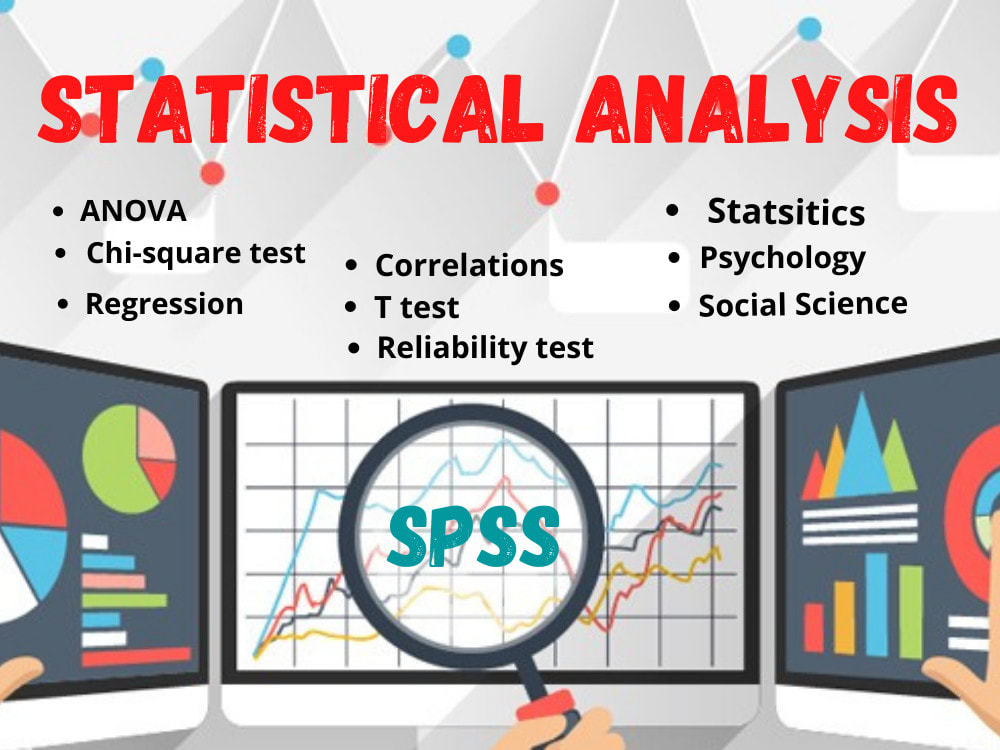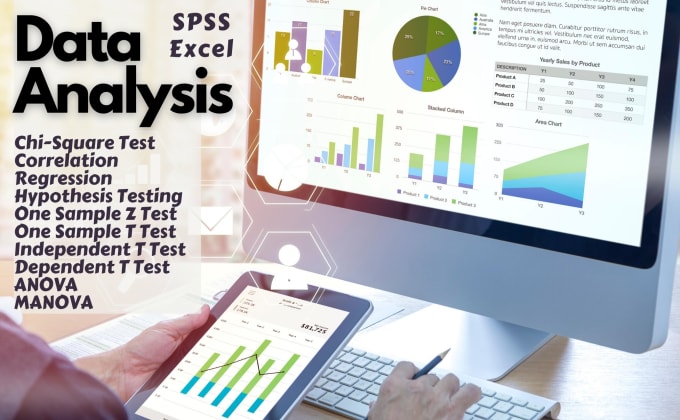Tips for SPSS Beginners|2025
Discover essential Tips for SPSS Beginners to build a strong foundation in data analysis. Learn how to navigate the interface, enter data correctly, choose the right tests, and interpret output effectively. Perfect for students and first-time users aiming to master SPSS with confidence.
Familiarize Yourself with the SPSS Interface
Understanding the SPSS interface is the first step towards effective data analysis. The main components include:
-
Data View: Displays your dataset in a spreadsheet format, where rows represent cases and columns represent variables.
-
Variable View: Allows you to define and manage your variables, including names, types, and labels.
Import Data Efficiently
SPSS supports various data formats such as Excel, CSV, and TXT files. To import data:
-
Go to File > Open > Data.
-
Select your file format and locate your dataset.
-
Ensure variables are assigned correctly during import.
Define Variables Properly
Accurate variable definition ensures meaningful analysis:
-
Variable Names: Use short, descriptive names without spaces or special characters.
-
Variable Type: Choose appropriate types (e.g., numeric, string).
-
Value Labels: Assign labels to categorical variables for clarity.
Clean Your Data
Data cleaning is crucial for reliable results:
-
Identify Missing Data: Use Analyze > Descriptive Statistics > Frequencies to detect blanks.
-
Handle Outliers: Visualize data using boxplots (Graphs > Chart Builder).
-
Transform Variables: Use Transform > Compute Variable to create new variables or recode existing ones.
Utilize SPSS Syntax
SPSS Syntax allows for automation and reproducibility:
-
Generate Syntax: Use the “Paste” button instead of “OK” in dialog boxes to generate syntax.
-
Modify and Run: Edit and execute commands in the Syntax Editor.
-
Save Syntax Files: Store syntax files for future use, ensuring consistency.
Create Effective Visualizations
Visual representations enhance data interpretation:
-
Chart Builder: Access via Graphs > Chart Builder.
-
Choose Chart Types: Select appropriate charts like histograms, bar charts, or scatterplots.
-
Customize: Adjust titles, labels, and color schemes for clarity.
Interpret SPSS Output Carefully
Understanding SPSS output is vital:
-
Key Metrics: Focus on p-values, confidence intervals, and effect sizes.
-
Tables and Charts: Review tables and charts that summarize your results.
-
Formatting: Use APA formatting for academic reports.
Save and Export Your Work
Preserve your work and share results:
-
Save Data: Use File > Save As to save datasets as .sav files.
-
Export Outputs: Export outputs to Word or PDF via File > Export.
-
Backup: Always back up your files to prevent data loss.
Engage with the SPSS Community
Learning from others can accelerate your progress:
-
Online Communities: Join forums and groups where SPSS users share knowledge and experiences.
-
Seek Help: Don’t hesitate to ask questions and seek assistance when needed.
Practice Regularly
Hands-on experience is the best way to learn:
-
Real Datasets: Work with publicly available datasets to apply your skills.
-
Consistent Practice: Regularly use SPSS to become more comfortable and proficient.
Understand Levels of Measurement
SPSS uses measurement levels to determine how variables are treated statistically:
-
Nominal: Categories without inherent order (e.g., gender, country)
-
Ordinal: Categories with order but not equal intervals (e.g., education level)
-
Scale (Interval/Ratio): Continuous variables with equal intervals (e.g., age, income)
Properly setting these levels in the Variable View helps SPSS determine which analyses are suitable. For example, you cannot compute a mean for a nominal variable like “marital status.”
Tip: Always double-check the “Measure” column in Variable View to avoid analysis errors or misleading outputs.
Use Split File and Select Cases Wisely
These two features allow you to perform subgroup analyses or isolate specific cases for analysis.
-
Split File: Found under Data > Split File, it enables you to analyze data by groups (e.g., compare males vs. females).
-
Select Cases: Found under Data > Select Cases, it lets you include or exclude cases based on conditions (e.g., only analyzing respondents above age 30).
Tip: Always turn off Split File and Select Cases when you’re done, or future analyses may be affected.
Know the Difference Between Recode and Compute
-
Recode is used when you want to convert variable values. For example, turning a 5-point Likert scale into 3 categories (e.g., 1–2 = Disagree, 3 = Neutral, 4–5 = Agree).
-
Use Transform > Recode into Same Variables or Recode into Different Variables.
-
-
Compute is used to create new variables based on formulas (e.g., computing the total score from multiple questions).
-
Use Transform > Compute Variable.
-
Tip: Always test your computed or recoded variables by running Frequencies or Descriptives to confirm the transformation worked as expected.
Document Your Process
Documentation is crucial, especially when working in teams or revisiting projects later. SPSS provides several ways to document your work:
-
Syntax Comments: Use an asterisk (*) before a line to write a comment in the Syntax Editor.
-
Output Notes: Add notes to output sections using the right-click context menu.
-
Data Documentation: Use the Label and Value Labels fields in Variable View to clarify what variables and codes mean.
Tip: Good documentation can save you hours of confusion in the future, especially when sharing your work.
Use Descriptive Statistics Before Inferential Tests
Before jumping into t-tests, regressions, or ANOVA, always run descriptive statistics. This helps you:
-
Check data quality
-
Understand variable distributions
-
Identify potential outliers or errors
Use:
-
Analyze > Descriptive Statistics > Frequencies
-
Analyze > Descriptive Statistics > Descriptives
-
Graphs > Chart Builder (for histograms, boxplots, etc.)
Tip: A strong understanding of your data reduces the risk of incorrect statistical assumptions.
Save Syntax and Output Files Separately
SPSS files come in different types:
-
.sav: Data files
-
.sps: Syntax files
-
.spv: Output files
Always save your syntax separately so that your analysis can be reproduced or modified later. Even if you’re using the GUI, clicking “Paste” before “OK” creates a record of your commands.
Tip: Adopt a consistent naming convention, such as
project1_cleaned.sav,project1_analysis.sps, andproject1_results.spv.
Avoid Common Mistakes in SPSS
Even experienced users can fall into these traps:
-
Forgetting to change a variable’s type from string to numeric
-
Running analyses on missing or unclean data
-
Misinterpreting output (especially p-values or direction of effects)
-
Copy-pasting outputs without checking the assumptions of the test
-
Not saving your work frequently (SPSS doesn’t autosave!)
Tip: Use a checklist when preparing data and running analyses to avoid these pitfalls.
Learn How to Interpret Key Outputs
Here are some examples of essential outputs and how to interpret them:
T-Test Output
-
Look at Levene’s Test to determine equal variances.
-
Focus on the Sig. (2-tailed) value: p < .05 usually indicates a significant difference between groups.
Regression Output
-
R²: Indicates how much variance is explained by the model.
-
Coefficients Table: Pay attention to B, Beta, and Sig. values.
ANOVA Output
-
Look for F and Sig. values.
-
If significant, follow up with Post Hoc Tests (e.g., Tukey).
Tip: Don’t rely solely on p-values. Consider effect sizes and confidence intervals for meaningful insights.
Explore SPSS Help and Tutorials
SPSS includes built-in help and tooltips for almost every function:
-
Use Help > Topics for detailed guides.
-
Hover over variable names and icons for descriptions.
-
Access the IBM Knowledge Center online for tutorials and user manuals.
Additionally, popular resources include:
-
YouTube channels (e.g., Research By Design, Global Stats Academy)
-
Free courses (e.g., Coursera, YouTube, Udemy)
-
SPSS books for beginners like “SPSS Survival Manual” by Julie Pallant
Tip: Bookmark helpful links and videos in a dedicated “SPSS Resources” folder.
Integrate SPSS with Other Tools
While SPSS is powerful, it can be complemented by other software:
-
Excel: For data entry, visualization, or preliminary calculations.
-
Word/PDF: Export outputs for reports.
-
R/Python: For advanced data processing and custom scripting.
SPSS also supports:
-
Python Plugins (for automation)
-
R integration (via R Essentials module)
Tip: Knowing a second data analysis tool (like R) can increase your flexibility as a data analyst.
Customize SPSS for a Better Workflow
SPSS can be tailored to suit your preferences:
-
Change the default output style: Go to Edit > Options > Output Labels to customize tables.
-
Use templates for output appearance: Save your favorite chart styles and formatting.
-
Set default folder paths for data and output files under Edit > Options > File Locations.
Tip: Making SPSS “yours” reduces friction and speeds up routine tasks.
Practice with Real-World Data Sets
Theory is essential, but practical application builds confidence. Here are some public datasets to practice on:
Use these datasets to:
-
Test data cleaning techniques
-
Build basic and advanced statistical models
-
Explore storytelling with data
Learn Data Visualization Best Practices
Creating clear and meaningful graphs is crucial:
-
Avoid chart junk: Keep charts simple and focus on key messages.
-
Label axes and titles clearly
-
Use color purposefully to differentiate groups
SPSS’s Chart Editor lets you fine-tune your visuals. Alternatively, you can export data to Excel for additional visualization tools.
Develop Your Analytical Thinking
SPSS is a tool—your critical thinking makes the difference. As you grow:
-
Focus on asking the right questions.
-
Learn to challenge results and consider alternative explanations.
-
Use SPSS to support, not replace, logical reasoning.
Don’t Fear Mistakes—They’re Part of Learning
Everyone makes errors in SPSS. Whether it’s a misplaced decimal or selecting the wrong test, mistakes are normal and essential for growth.
Tip: Keep a journal or notes about what you learned from each mistake. Over time, this log becomes a powerful learning tool.
Conclusion: Building SPSS Confidence Step by Step
Mastering SPSS takes time, practice, and patience. But with the right approach, even the most hesitant beginner can become a confident data analyst. Let’s recap the most important tips:
-
Understand the interface—Data View and Variable View are your foundation.
-
Clean your data before analysis.
-
Practice syntax, even if you prefer the GUI.
-
Document everything—from variables to tests.
-
Explore descriptive stats before running complex models.
-
Engage with the SPSS community and keep learning.
Remember, SPSS is just a tool. Your curiosity, problem-solving skills, and commitment to learning will determine your success. Take your time, explore real-world problems, and don’t be afraid to experiment.
Needs help with similar assignment?
We are available 24x7 to deliver the best services and assignment ready within 3-4 hours? Order a custom-written, plagiarism-free paper






